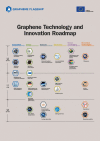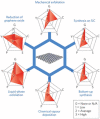Evolving Strategies for Producing Multiscale Graphene-Enhanced Fiber-Reinforced Polymer Composites for Smart Structural Applications
- PMID: 32537406
- PMCID: PMC7284224
- DOI: 10.1002/advs.201903501
Evolving Strategies for Producing Multiscale Graphene-Enhanced Fiber-Reinforced Polymer Composites for Smart Structural Applications
Abstract
Graphene has become an important research focus in many current fields of science including composite manufacturing. Developmental work in the field of graphene-enhanced composites has revealed several functional and structural characteristics that promise great benefits for their use in a broad range of applications. There has been much interest in the production of multiscale high-performance, lightweight, yet robust, multifunctional graphene-enhanced fiber-reinforced polymer (gFRP) composites. Although there are many reports that document performance enhancement in materials through the inclusion of graphene nanomaterials into a matrix, or its integration onto the reinforcing fiber component, only a few graphene-based products have actually made the transition to the marketplace. The primary focus of this work concerns the structural gFRPs and discussion on the corresponding manufacturing methodologies for the effective incorporation of graphene into these systems. Another important aspect of this work is to present recent results and highlight the excellent functional and structural properties of the resulting gFRP materials with a view to their future applications. Development of clear standards for the assessment of graphene material properties, improvement of existing materials and scalable manufacturing technologies, and specific regulations concerning human health and environmental safety are key factors to accelerate the successful commercialization of gFRPs.
Keywords: composites; graphene; polymers; smart materials.
© 2020 Swinburne University of Technology. Published by WILEY‐VCH Verlag GmbH & Co. KGaA, Weinheim.
Conflict of interest statement
The authors declare no conflict of interest.
Figures













References
-
- Mirabedini A., Foroughi J., Wallace G. G., RSC Adv. 2016, 6, 44687.
-
- Wang R.‐M., Zheng S.‐R., Zheng Y.‐P., in Polym. Matrix Compos. Technol., Woodhead Publishing, Sawston, Cambridge, UK: 2011, pp. 1–25.
-
- Baekeland L. H., J. Ind. Eng. Chem. 1909, 1, 149.
-
- Sperling L. H., Introduction to Physical Polymer Science, Wiley, New York: 2006.
-
- Hu K., Kulkarni D. D., Choi I., Tsukruk V. V., Prog. Polym. Sci. 2014, 39, 1934.
Publication types
LinkOut - more resources
Full Text Sources
